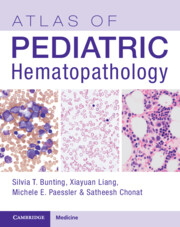Book contents
- Atlas of Pediatric Hematopathology
- Atlas of Pediatric Hematopathology
- Copyright page
- Contents
- Contributors
- Section I Peripheral Blood
- Chapter 1 Peripheral Blood Smear Review
- Chapter 2 Red Blood Cell Disorders
- Chapter 3 Neutrophil and Platelet Disorders
- Chapter 4 Infectious Diseases and Nutritional Deficiencies
- Section II Normal and Non-neoplastic Hematolymphoid Diseases
- Section III Mature Lymphoid Neoplasm
- Section IV Precursor Hematopoietic Neoplasms and Related Neoplasms
- Section V Histiocytic Neoplasm and Miscellaneous Bone Marrow Diseases
- Index
- References
Chapter 1 - Peripheral Blood Smear Review
from Section I - Peripheral Blood
Published online by Cambridge University Press: 25 November 2023
- Atlas of Pediatric Hematopathology
- Atlas of Pediatric Hematopathology
- Copyright page
- Contents
- Contributors
- Section I Peripheral Blood
- Chapter 1 Peripheral Blood Smear Review
- Chapter 2 Red Blood Cell Disorders
- Chapter 3 Neutrophil and Platelet Disorders
- Chapter 4 Infectious Diseases and Nutritional Deficiencies
- Section II Normal and Non-neoplastic Hematolymphoid Diseases
- Section III Mature Lymphoid Neoplasm
- Section IV Precursor Hematopoietic Neoplasms and Related Neoplasms
- Section V Histiocytic Neoplasm and Miscellaneous Bone Marrow Diseases
- Index
- References
Summary
Despite all the advances in laboratory medicine, microscopic review of the peripheral blood smear is still highly informative and clinically relevant and remains an indispensable diagnostic tool. In a pediatric hospital, a common and challenging request is the evaluation of a newborn blood smear. This chapter provides an overview of some of the characteristics of a newborn smear and common reactive conditions.
Blood smear evaluation is often performed for three essential reasons: first, to clarify a flagged result such as immature cells or a low platelet count to rule out pseudo-thrombocytopenia from platelet clumping; second, to evaluate the morphology of red blood cells, white blood cells, and platelets; and, third, to confirm morphologic findings identified by lab staff or an instrument [1]. The latter may be requested by a physician due to a clinical suspicion or by members of the laboratory staff for review of an abnormal finding.
- Type
- Chapter
- Information
- Atlas of Pediatric Hematopathology , pp. 1 - 8Publisher: Cambridge University PressPrint publication year: 2023



